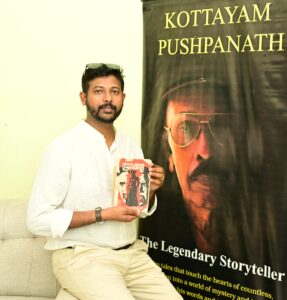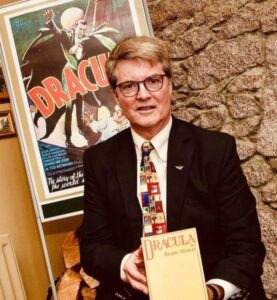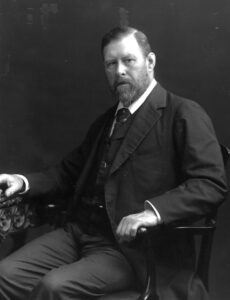Long before cinematic universes became a trend, Kottayam Pushpanath had already built one in print.
Published Nov 20, 2025 | 5:00 PM ⚊ Updated Dec 01, 2025 | 8:17 AM

Kottayam Pushpanath (1937-2018).
Synopsis: Come January, Kottayam Pushpanath’s translation of ‘Dracula’ will make a grand return. This time, Pushpanath is not alone: the original author, Bram Stoker’s family, too, is involved.
The shadows on the wall changed shape as the kerosene lamp flickered. The dark, dancing patterns were reminiscent of spooky and often made-up characters in grandmother’s tales.
An oily fragrance filled the room, where a young woman lay on the bare floor with her head towards the lamp, a book in hand.
Crickets have long fallen silent after their chirps had warned Kottayam of the impending rain. The pitter-patter of the spitting rain, normally soothing and melodious, scared her that night as she flipped pages with rapt attention.
Somewhere far away, a dog barked briefly, startling the woman. She shot a furtive glance at the window, and failed to see the familiar, friendly silhouettes — darker than the darkness — on that rainy night. She felt a chill running down her spine as some unknown force held her down and guided her eyes back to the pages.
The enigmatic Transylvanian nobleman has come alive on the page and was welcoming his guest, Jonathan Harker, who had braved the eerie night to arrive at the castle.
”I am Dracula and I bid you welcome, Mr Harker, to my house. Come in. The night is chill, and you must need to eat and rest.”
Her heart raced. Harker’s trip to the castle itself had unsettled her. She feared to read the next sentence, but some force hitherto unknown made her continue. The woman felt as if she was at the Count’s imposing castle in the Carpathians, the biting wind swirling and holding her in an inescapable embrace.
It was real, she felt, as the moon remained hidden behind the clouds. The printed words changed form, became vivid images and characters, and whispered to her from the shadows.
In the mid-1970s, Kerala’s housewives, students, and even daily-wage workers came face-to-face with Whitby, the Carpathian mountains, and Dracula’s shadowy world.
Several of them had not seen Bram Stoker’s English classic, but they all knew Dracula’s world, because they were familiar with Kottayam Pushpanath’s Dracula, written in Malayalam.
Now, five decades later, the Malayalam Dracula is returning, this time relaunched by his grandson, Rayan Pushpanath, in association with the Stoker family itself. Dacre Stoker, the great-grand-nephew of Bram Stoker, is part of this historic revival planned for January 2026.
Kottayam Pushpanath died in 2018, aged 80, leaving behind a wealth of stories that had captivated generations. Before taking his final bow, he entrusted his literary treasures to his grandchild, Rayan Pushpanath.

Rayan Pushpanath with a copy of the Malayalam Dracula
Growing up in Kottayam, Rayan watched his grandfather weave magical tales — yet he never touched the writing table—it hid a pistol, and a brim hat sat on it like a mysterious guardian.
In a conversation with South First, Rayan recounted how he came to relaunch Dracula.
”It was in 1975 when Papa translated Bram Stoker’s Dracula. But he did more than translate; he reimagined it through an Indian lens, weaving nearly ten interconnected novels that transported the vampire across Asian landscapes, Indian legends, and Kerala’s own cultural tapestry. Long before cinematic universes became a trend, my grandfather had already built one in print.” he said.
From Dracula in Asia and Dracula in Brazil to Dracula‘s Daughter, Dracula Awakens, In the Shadow of Dracula, and Dracula Returns, he uniquely placed Dracula across multiple settings.

Kottayam Pushpanath’s original manuscript.
There might be no other novelist in the world who has explored Dracula in such diverse terrains and built an entire series around him.
The Malayalam Dracula Universe was more than mere entertainment—it was an experience, a phenomenon. And in 2025, global acknowledgement arrived when British writer Ann Morgan, famed for her A Year of Reading the World, featured Dracula in Asia (Dracula Asiayil) in her book, Relearning to Read, highlighting how stories could transcend borders and cultures.
Yet the original 1975 edition had vanished.
Not a single copy survived in libraries, archives, or private collections. The disappearance was made more poignant by Kerala’s devastating floods around the time of Pushpanath’s passing, which swallowed countless rare books and classics.

Dacre Stoker, Bram Stoker’s great-grand-nephew.
Rayan spent seven years sifting through libraries, ancestral homes, second-hand bookstores, and private archives. Floods had washed away many books, and tracking them down felt almost like a detective’s quest.
Then, in 2024, at a book fair in Kannur, the impossible came to pass. A longtime fan, AR Jithendran Potuvacheri, whispered the words Rayan had been hoping for: ”Yes, I have it.” The rediscovery of that volume transformed Rayan’s path.
Preparing the new edition drew him into a role he had long shied from — that of a writer. His first undertaking was translating Bram Stoker’s long-forgotten short story, Dracula’s Guest, into Malayalam—a tale originally intended as part of the novel but eclipsed by time.
Rayan said translating it felt like walking between two giants—Bram Stoker on one side and his grandfather on the other.
In Kottayam, Rayan set out on a quest as thrilling as stepping into Dracula’s world. Just like Jonathan Harker in the Carpathian mountains, he wanted to connect with the Stoker family.

Bram Stoker
While in the UK, the Bram Stoker Estate Foundation had already restored most of Stoker’s works under the careful stewardship of Dacre Stoker, Bram’s great-grand-nephew.
Rayan’s challenge was to forge a connection with this lineage of the literary vampire.
Finally, through the foundation, he reached Dacre. When Rayan revealed the unlikely fame of Dracula in the small Indian state of Kerala, Dacre’s surprise mirrored the flicker of a candle in a dark castle hall.
The idea of the Count’s shadow crossing continents intrigued him, and he agreed to lend his support to the relaunch.
As Kottayam Pushpanath Publications prepares the new Malayalam edition of Dracula, the introduction bears the name of Bram Stoker, as if the Count was whispering through time.
This edition also contains a rare interview between Rayan and Stoker, and the second chapter, long lost to the world, was finally restored.
British visual artist Gerald Scarfe illustrated the cover — the same Scarfe whose strokes had once brought Hercules to life for Walt Disney. The back pages featured illustrations by Shani Rhys James, who was appointed a Member of the Order of the British Empire for services to art.
While Dracula’s powers peaked only after sunset, Kottayam Pushpanath’s detectives, Marxin and Pushparaj, were limitless in their intelligence 24×7. Detective Pushparaj investigated the mysteries set in India, while Marxin took the lead in tales unfolding abroad.

Shani Rhys James (top) and Gerald Scarfe.
In the grand tradition of Sherlock Holmes and Hercule Poirot, Pushpanath crafted detectives who knew no boundaries.
Rayan revealed to South First that, ”Marxin and Pushparaj aren’t just returning through book relaunches, they may soon leap onto screens via series on platforms like Netflix and Amazon Prime. Talks are underway.” he said.
Rayan was particularly astonished to learn that his grandfather’s detective and mystery novels had crossed linguistic borders, being translated into Telugu, Kannada, Tamil, Bengali, and Gujarati.
In an era without the internet, through sleepless nights with National Geographic magazine and the globe, he discovered places in the UK, Brazil, and beyond, making them familiar to Malayali readers.
Two of Pushpanath’s novels—Brahmarakshass and Chuvanna Anki became Malayalam films, while Chuvanna Manushyan found a place in the syllabus of Mahatma Gandhi and Kerala universities. His mystery thriller, Souparnika, was serialised in Tamil.
Kerala owes an enduring debt to legends like Kottayam Pushpanath, Neelakantan Paramara, Veloor PK Ramachandran, OM Cheriyan, and others who built this thrilling legacy. Their stories are not just read—they are lived, remembered, and awaited with bated breath.
And from the heart of the Carpathians to the heart of Kerala, the castle waits—for the Count, who is returning!
(Edited by Majnu Babu).
